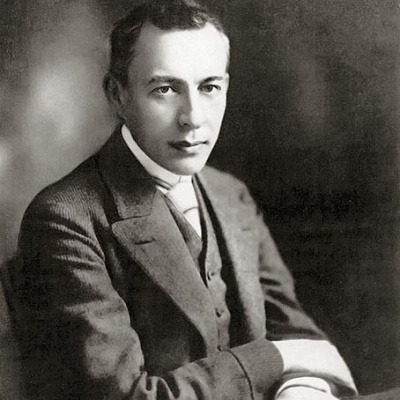
Sergei Rachmaninov
谢尔盖·瓦西里耶维奇·拉赫玛尼诺夫(俄语:Сергей Васильевич Рахманинов,1873年4月1日-1943年3月28日)是一位出生于俄国的作曲家、指挥家及钢琴演奏家,1943年临终前入美国籍。他的作品甚富俄国色彩,充满激情、旋律优美,其钢琴作品更是以难度见称。 水星上位于27.6° N, 302.4° W的陨石坑以他的名字命名。 生平 1873年4月1日,拉赫玛尼诺夫诞生于俄国的大诺夫哥罗德附近的谢苗诺沃(Семёново),出身于地主家庭,家境富裕,父母皆为业余钢琴演奏家,母亲是他的第一位钢琴教师。拉赫玛尼诺夫从四岁开始习琴,然而最初并无突出的表现。 由于家道中落,拉赫玛尼诺夫一家迁往圣彼得堡。1882年,拉赫玛尼诺夫入读当地的圣彼得堡音乐学院,1885年经介绍往莫斯科拜师尼古拉·兹韦列夫(Николай Зверев/Nikolai Zverev)门下接受严格的钢琴训练。 艰苦的训练,令拉赫玛尼诺夫不久便展露出他的天份:他编写的歌剧《Aleko》获奖;19岁时,编写了著名的《升c小调钢琴前奏曲》,成为他于乐坛上的代表作;同年更完成他的《第一钢琴协奏曲》。1892年,拉赫玛尼诺夫于莫斯科音乐学院第一荣誉毕业,并开始他的作曲生涯。 1897年,拉赫玛尼诺夫《第一交响乐》的首演招来劣评如潮,令他受到很大打击,他亦因而无法集中精神作曲。后来经了解,由于当天的指挥亚历山大·康斯坦丁诺维奇·格拉祖诺夫并无充份练习,再加上指挥于演奏时醉酒,以致整个首演表现得一塌糊涂。但拉赫玛尼诺夫并未因而振作起来,往后的数年更因此停产,直至得到心理治疗师尼可莱·达尔的医治,才重拾自信。1900年,拉赫玛尼诺夫完成他的《第二钢琴协奏曲》,并以此献给尼可莱·达尔,他更亲自于首演中担任钢琴独奏。该次演出为大众所接纳,令《第二钢琴协奏曲》成为大众喜爱的作品。 拉赫玛尼诺夫除作曲外,亦是一位杰出的指挥家,他于1904年担任莫斯科大剧院(Bolshoi Theatre)的指挥。在俄国,他被誉为最杰出的歌剧指挥。1906年,由于俄国政治上的动荡(见“1905年俄国革命”),拉赫玛尼诺夫举家离开俄国暂居意大利,后来再迁往德国德累斯顿,期间他编写著名的《第二交响乐》,并于欧洲多国巡回指挥。 1909年,拉赫玛尼诺夫第一次往美国表演,他为表演更编写了被誉为最困难的《第三钢琴协奏曲》,令他在美国大受欢迎。回到俄国后,拉赫玛尼诺夫担任莫斯科爱乐交响乐团的指挥,成为当地乐界举足轻重的人物。 1914年,俄国政治十分动荡,不少剧院为免受暴民破坏而关闭,最初拉赫玛尼诺夫并无离开祖国之意,但由于他出身富裕家庭,又曾是地主,拉赫玛尼诺夫开始意识到周围的危险。1917年,拉赫玛尼诺夫获邀到瑞典演出,他乘此良机举家离开俄国,最终于1918年移居美国。为谋生计,拉赫玛尼诺夫开始其钢琴演奏生涯,在他人生余下的廿多年里,于美国及欧洲各地演奏,但却再无踏足祖国的机会。 1931年,拉赫玛尼诺夫于瑞士琉森湖边置业,按照旧居模样布置,并编写了以钢琴及交响乐演奏的《帕格尼尼主题狂想曲》。 拉赫玛尼诺夫曾经说过:“我感到我工作时比闲散时更强,所以我祈求上帝让我工作到生命的最后一天。”七十岁时,拉赫玛尼诺夫仍不停四处演出,直至于1943年2月才因身体不适被逼停止下来,然而不久却诊断出患了黑色素瘤,他返回美国治疗。同年3月,拉赫玛尼诺夫病情恶化致无法进食,到了3月26日更陷入昏迷状态。一群音乐家联名以电报预祝他的七十岁大寿,可惜他却无缘庆祝自己的诞辰,最终于1943年3月28日于加利福尼亚辞世。 在拉赫玛尼诺夫离开俄国前,曾编写弥撒曲《Vesper Mass》,这亦是他为自己丧礼编写的作品,当中一句歌词(英译版本)如下: Lord, now lettest Thou Thy servant depart in peace. 主,现在就让你的仆人在平安中离去。 佚事 钢琴对小时候的拉赫玛尼诺夫是一件惩罚工具,据说其母惩罚小拉赫玛尼诺夫时,会要求他坐在钢琴底下。 拉赫玛尼诺夫的身材高大,拥有一双巨大的手,左手能轻易按到跨十二度的琴键,故此并非所有人能演奏他的作品。他的身材可能与一种名为马凡氏综合症的遗传病有关,患者其中一个征状是修长的四肢及手指。 拉赫玛尼诺夫曾居于其师兹韦列夫的寓所内,由于同学们练习的声音过份嘈吵,拉赫玛尼诺夫向其师要求一个较宁静的环境以专心作曲而引发争执,最终令两师徒拆伙。(*另一说法为前途问题上的分歧:老师兹韦列夫一心栽培拉赫玛尼诺夫成为出色的钢琴家,然而年青的拉赫玛尼诺夫只希望专心发挥作曲才能。) 拉赫玛尼诺夫于莫斯科音乐学院毕业时,获评审委员一致推举为第一荣誉毕业生,其师兹韦列夫亦是评审委员之一。兹韦列夫于毕业礼时,更以金表作为贺礼赠予拉赫玛尼诺夫,两师徒亦冰释前嫌,此金表亦成为拉赫玛尼诺夫珍而重之的物品。 拉赫玛尼诺夫接受心理治疗时,其治疗师尼古拉·达利(Никола́й Даль/Nikolai Dahl)要求他每天接受诊治,拉赫玛尼诺夫每次均需坐于漆黑的房间内,听治疗师不停重复说:“你将开始创作协奏曲…你会工作得称心如意…你的协奏曲会是最好的…”拉赫玛尼诺夫最终于诊疗期末时,完成了著名的《第二钢琴协奏曲》。 拉赫玛尼诺夫于1902年与Natalia结婚,其意大利籍的妻子亦是毕业于莫斯科音乐学院的钢琴家。 拉赫玛尼诺夫喜欢于安静的环境创作,他曾说:“没有比安静独处对我更有帮助。” “拉赫曼尼”在俄语有“挥霍无度”之意,拉赫玛尼诺夫之父正是一个胡乱挥霍的赌徒,最后更典当家业,弃妻儿不顾。 重要作品 拉赫玛尼诺夫编写了五首以钢琴及交响乐协奏的作品,分别为四首钢琴协奏曲及《帕格尼尼主题狂想曲》(Rhapsody on a Theme of Paganini),其中以《第二钢琴协奏曲》及《第三钢琴协奏曲》最著名,《帕格尼尼主题狂想曲》中一段行板(Var.18)更是脍炙人口之作,被电影《似曾相识》(Somewhere in Time)采纳为背景音乐。 钢琴独奏方面,最著名的包括有《升c小调前奏曲》。拉赫玛尼诺夫亦曾把多首古典音乐作品改编成钢琴独奏版本,较著名的有巴哈的前奏曲、里姆斯基-科萨科夫的大黄蜂的飞行、弗里茨·克莱斯勒的爱之悲及爱之喜等。 拉赫玛尼诺夫曾编写多首交响乐作品。《第一交响曲》对拉赫玛尼诺夫而言是失败之作,他甚至把手稿撕毁,直至他死后,整份乐谱被才发现收藏于列宁格勒音乐学院中,至1948年才于美国作第二次公演以纪念拉赫玛尼诺夫逝世五周年。然而,《第二交响曲》及《第三交响曲》仍是较出名的作品。拉赫玛尼诺夫亦曾编写多首交响诗,如:Isle of the Dead、The Rock、Symphonic Dances等。 拉赫玛尼诺夫亦有编写声乐及合唱作品,包括有弥撒曲Vesper Mass、The Liturgy of St. John Chrysostom及The Bells。短歌Vocalise更被改编成不同乐器的独奏曲。 Sergei Vasilievich Rachmaninoff (Russian: Сергей Васильевич Рахманинов; 1 April [O.S. 20 March] 1873 – 28 March 1943) was a Russian-born composer, pianist, and conductor. Rachmaninoff is widely considered one of the finest pianists of his day and, as a composer, one of the last great representatives of Romanticism in Russian classical music. Early influences of Tchaikovsky, Rimsky-Korsakov, and other Russian composers gave way to a personal style notable for its lyricism, expressiveness, structural ingenuity, and his use of rich orchestral colors. The piano is featured prominently in Rachmaninoff's compositional output, and through his own skills as a performer he explored the expressive possibilities of the instrument. (wiki) ==================================== by Michael Rodman Sergey Vasilyevich Rachmaninov, born in Semyonovo, Russia, on April 1, 1873, is today remembered as one of the most formidable pianists of all time and the last truly great composer in the Russian Romantic tradition. Rachmaninov came from a music-loving, land-owning family; young Sergey's mother fostered the boy's innate talent by giving him his first piano lessons. After a decline in the family fortunes, the Rachmaninovs moved to St. Petersburg, where Sergey studied with Vladimir Delyansky at the Conservatory. As his star continued to rise, Sergey went to the Moscow Conservatory, where he received a sound musical training: piano lessons from the strict disciplinarian Nikolay Zverev and Alexander Siloti (Rachmaninov's cousin), counterpoint with Taneyev, and harmony with Arensky. During his time at the Conservatory, Rachmaninov boarded with Zverev, whose weekly musical Sundays provided the young musician the valuable opportunity to make important contacts and to hear a wide variety of music. As Rachmaninov's conservatory studies continued, his burgeoning talent came into full flower; he received the personal encouragement of Tchaikovsky, and, a year after earning a degree in piano, took the Conservatory's gold medal in composition for his opera Aleko (1892). Early setbacks in his compositional career -- particularly, the dismal reception of his Symphony No. 1 (1895) -- led to an extended period of depression and self-doubt, which he overcame with the aid of hypnosis. With the resounding success of his Piano Concerto No. 2 (1900-1901), however, his lasting fame as a composer was assured. The first decade of the twentieth century proved a productive and happy one for Rachmaninov, who during that time produced such masterpieces as the Symphony No. 2 (1907), the tone poem Isle of the Dead (1907), and the Piano Concerto No. 3 (1909). On May 12, 1902, the composer married his cousin, Natalya Satina. By the end of the decade, Rachmaninov had embarked on his first American tour, which cemented his fame and popularity in the United States. He continued to make his home in Russia but left permanently following the Revolution in 1917; he thereafter lived in Switzerland and the United States between extensive European and American tours. While his tours included conducting engagements (he was twice offered, and twice refused, leadership of the Boston Symphony Orchestra), it was his astounding pianistic abilities which won him his greatest glory. Rachmaninov was possessed of a keyboard technique marked by precision, clarity, and a singular legato sense. Indeed, the pianist's hands became the stuff of legend. He had an enormous span -- he could, with his left hand, play the chord C-E flat-G-C-G -- and his playing had a characteristic power, which pianists have described as "cosmic" and "overwhelming." He is, for example, credited with the uncanny ability to discern, and articulate profound, mysterious movements in a musical composition which usually remain undetected by the superficial perception of rhythmic structures. Fortunately for posterity, Rachmaninov recorded much of his own music, including the four piano concerti and what is perhaps his most beloved work, the Rhapsody on a Theme of Paganini (1934). He became an American citizen a few weeks before his death in Beverly Hills, CA, on March 28, 1943.
